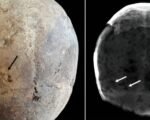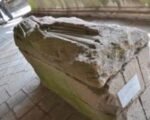In a remarkable discovery, fossil hunters in Texas have unearthed jaw bones belonging to the prehistoric marine reptile Globidens alabamaensis. These fossils, found in the Ozan Formation, date back to the Late Cretaceous period, approximately 80 million years ago. The jaw bones, featuring unique globular teeth, provide new insights into the diet and lifestyle of this ancient sea monster. This discovery, detailed in the Journal of Paleontological Sciences, highlights the evolutionary adaptations that allowed Globidens alabamaensis to thrive in its marine environment.
Unearthing the Fossils
The discovery of the Globidens alabamaensis jaw bones was made by a private fossil hunter in 2023. The fossils were found in an 8-inch-thick deposit in the Ozan Formation, located in northeastern Texas. This area is known for its rich fossil deposits, which have yielded numerous specimens from the Late Cretaceous period. The jaw bones, which include 12 teeth in one fragment and six in another, are notable for their rounded, globular shape.
These unique teeth were perfectly adapted for crushing the shells of turtles, mollusks, and other hard-shelled prey. This adaptation allowed Globidens alabamaensis to occupy a specific ecological niche, coexisting with other marine predators without direct competition for food. The presence of a tooth germ along the gumline of one jaw fragment suggests that, like sharks, mosasaurs shed and replaced their teeth throughout their lives.

The discovery of these jaw bones provides valuable information about the diet and feeding habits of Globidens alabamaensis. By analyzing the wear patterns on the teeth, researchers can infer the types of prey this marine reptile consumed and how it processed its food. This information helps to build a more complete picture of the marine ecosystem during the Late Cretaceous period.
Insights into Mosasaur Evolution
Globidens alabamaensis is a type of mosasaur, a group of large marine reptiles that dominated the oceans during the Late Cretaceous period. Unlike most mosasaurs, which had sharp, dagger-like teeth, Globidens alabamaensis evolved blunt, rounded teeth. This unique dental adaptation allowed it to exploit a different food source, reducing competition with other marine predators.
The evolutionary success of mosasaurs can be attributed to their ability to rapidly adapt to changing environmental conditions. During the Late Cretaceous period, many iconic marine predators, such as ichthyosaurs and plesiosaurs, became extinct due to climate changes and alterations in the marine ecosystem. Mosasaurs, including Globidens alabamaensis, filled the ecological niches left vacant by these extinctions, becoming the dominant predators of their time.
The discovery of the Globidens alabamaensis jaw bones adds to our understanding of mosasaur diversity and evolution. By studying these fossils, researchers can gain insights into the evolutionary pressures that shaped the development of different mosasaur species. This knowledge helps to explain how these ancient reptiles adapted to their environments and thrived in the prehistoric oceans.
The Significance of the Discovery
The discovery of the Globidens alabamaensis jaw bones is significant for several reasons. Firstly, it provides direct evidence of the dietary habits and ecological niche of this unique mosasaur species. The globular teeth of Globidens alabamaensis are a clear indication of its specialized feeding strategy, which involved crushing hard-shelled prey. This adaptation highlights the diversity of feeding strategies among mosasaurs and their ability to exploit different food sources.
Secondly, the discovery sheds light on the broader marine ecosystem of the Late Cretaceous period. By understanding the role of Globidens alabamaensis within this ecosystem, researchers can gain a better understanding of the interactions between different marine species and the dynamics of the prehistoric food web. This information is crucial for reconstructing the ecological history of the Late Cretaceous oceans.
Finally, the discovery underscores the importance of continued fossil exploration and research. Each new fossil find adds to our understanding of prehistoric life and the evolutionary history of our planet. The Globidens alabamaensis jaw bones are a testament to the rich fossil heritage of Texas and the valuable contributions of amateur fossil hunters to the field of paleontology.














